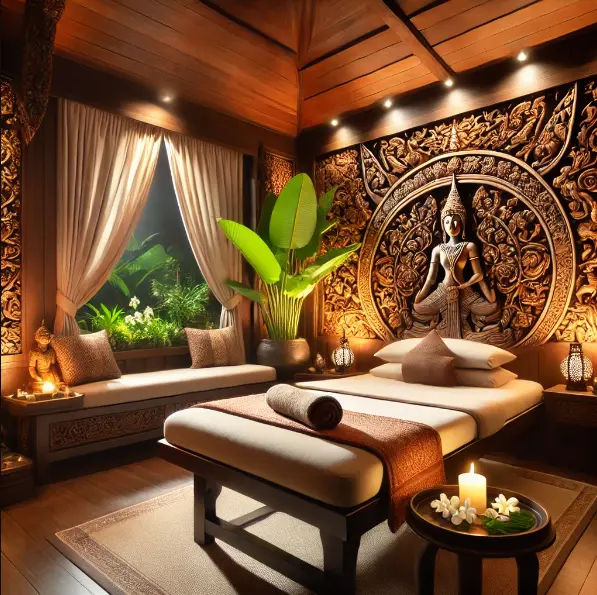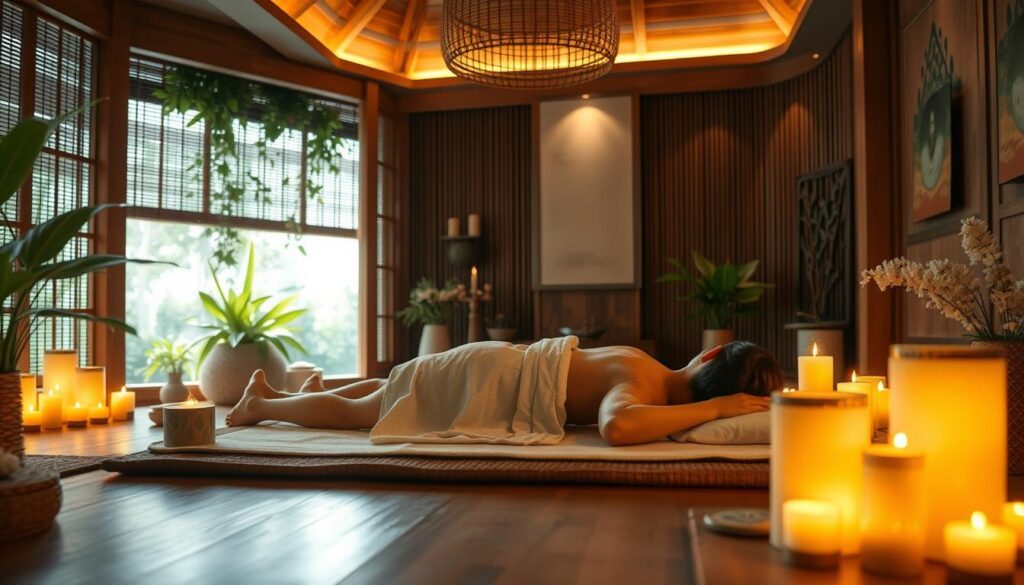
TEXT US

TEXT US
perththaimassage
November 13, 2024
Do not hesitate to contact us. Your enquiries is most welcome.

Thai massage is an ancient healing practice that has been around for more than 2,500 years. Originating in Thailand, this unique form of bodywork combines acupressure, Indian Ayurvedic principles, and assisted yoga postures. Unlike other massage techniques, Thai massage is all about rhythm and flow, making it a truly distinctive experience.
If you’ve never had a Thai massage before, you may be wondering what sets it apart from other types of massage therapy. Let’s dive into the details of what makes Thai massage so special and why it might be the perfect choice for you.
Thai massage, also known as “Nuad Bo-Rarn” in Thai, is deeply rooted in traditional Thai medicine. The practice incorporates the knowledge of energy lines in the body, known as “Sen.” The therapist uses a combination of palm pressing, thumb pressure, and gentle stretching to stimulate these energy lines, helping to balance the body’s energy flow.
What makes Thai massage unique is that it’s not performed on a traditional massage table. Instead, it usually takes place on a comfortable floor mat. The therapist uses their hands, knees, elbows, and even feet to move your body through various positions, much like yoga. But don’t worry—no prior yoga experience is needed!
Most people are familiar with massages that involve oils or lotions and focus on kneading and stroking muscles. Thai massage, on the other hand, is a fully clothed experience, and it does not use oils. Instead, it’s more interactive. The therapist will gently guide you into different stretches, using rhythmic pressure along the body’s energy lines.
According to research published by the Journal of Bodywork and Movement Therapies, Thai massage can significantly increase flexibility and muscle relaxation compared to conventional massage. This makes it especially beneficial for those who want to relieve muscle tightness or improve mobility.
Thai massage is known for its holistic benefits. Physically, it helps to relieve muscle tension, improve circulation, and enhance flexibility. Many people also report feeling a boost in their energy levels after a session. The National Institute of Health and Physical Fitness states that regular Thai massage can improve joint range of motion by up to 20%, which is ideal for those who experience stiffness or discomfort.
Mentally, the practice encourages relaxation and mindfulness. The meditative aspects of Thai massage can help reduce stress and anxiety. By working on the body’s energy lines, it promotes a sense of inner peace and balance, which is perfect for those dealing with the pressures of daily life.
If you’ve never had a Thai massage before, it’s natural to feel a bit hesitant. You might be concerned about the stretching or the interactive nature of the massage. However, Thai massage is highly adaptable to each person’s comfort level. The therapist will always adjust the pressure and stretches according to your needs, ensuring you feel relaxed and safe throughout the session.
At Perth Thai Massage, we have skilled therapists trained to cater to beginners. We take the time to understand your concerns and walk you through what to expect. You’re in good hands, and your comfort is our top priority.
If you’re looking for a massage that does more than just relax your muscles, Thai massage is worth a try. It provides a full-body experience that not only soothes sore muscles but also enhances your overall well-being. The combination of stretching, pressure, and energy work can leave you feeling revitalized and balanced.
In fact, a study from the International Journal of Traditional and Complementary Medicine found that 80% of participants experienced reduced muscle pain and increased relaxation after just one Thai massage session. With benefits like these, it’s no wonder more people are turning to this ancient healing practice.
👉 Want to learn how Thai massage can improve your overall health? Continue to our next article: “The Physical Benefits of Thai Massage.”
Thai massage, also known as Thai yoga massage, is deeply rooted in ancient Thai healing traditions and influenced by Ayurvedic medicine and yoga practices. Developed by Buddhist monks as a form of healing therapy. Thai massage aims to promote physical, mental, and spiritual well-being by balancing the body’s energy flow. Therfore, releasing blockages along energy pathways known as “sen.”
The hallmark of Thai massage lies in its unique combination. Of assisted stretching, rhythmic compression, and acupressure techniques. During a Thai massage session, the therapist uses their hands, elbows, knees, and feet. To apply pressure to specific points on the body. While also guiding the recipient through a series of gentle stretching movements reminiscent of yoga postures. This dynamic approach helps to improve flexibility, release tension. This is to restore harmony to the body, mind, and spirit.
The origins of Thai massage The origins of Thai massage can be traced back to ancient Thailand. Where it was developed by Buddhist monks as a therapeutic healing method. Drawing inspiration from Indian Ayurvedic medicine and traditional Chinese medicine. Thai massage incorporates elements of yoga, meditation, and energy work to promote overall wellness.
Thai massage offers numerous benefits, including alleviating muscular pain, improving flexibility, and enhancing circulation. It also promotes mental clarity, emotional balance, and spiritual awareness. Making it a holistic therapy for total wellness.

Regular massage employs a variety of techniques, including effleurage (long, gliding strokes), petrissage (kneading and squeezing motions), and friction (circular movements with pressure), among others. These techniques are designed to manipulate the soft tissues of the body. Including muscles, tendons, and ligaments, to promote relaxation, improve circulation, and alleviate pain.
Normal massage as above employs various techniques, including effleurage (long, gliding strokes), petrissage (kneading and squeezing motions), and friction (circular movements with pressure). These techniques manipulate the soft tissues of the body, including muscles, tendons, and ligaments, to promote relaxation, improve circulation, and alleviate pain.
The origins of normal massage can be traced back to Per Henrik Ling. A Swedish physician who developed a system of therapeutic massage known as Swedish massage. Drawing on techniques from Chinese, Egyptian, Greek, and Roman traditions. Ling created a comprehensive approach to massage therapy that focused on restoring balance and harmony to the body.
Normal massage provides a wide range of benefits. Including reducing muscle tension, promoting relaxation, improving circulation, and enhancing flexibility. It has also been shown to reduce stress, alleviate anxiety and depression, and relieve chronic pain conditions such as arthritis and fibromyalgia.
Both Thai massage and normal massage offer therapeutic benefits for individuals from all walks of life. For those in physically demanding professions, such as bricklayers. Both types of massage can provide relief from muscular tension, stiffness, and fatigue. The stretching techniques and acupressure points targeted in Thai massage. Can help alleviate muscle strain, improve flexibility, and enhance overall mobility. Similarly, the kneading and stroking techniques used in normal massage. Can soothe tired muscles, reduce inflammation, and alleviate discomfort from repetitive strain injuries.
Both Thai massage and normal massage offer unique approaches to healing and well-being. Each with its own set of techniques, origins, and benefits. Whether you’re drawn to the dynamic stretching movements of Thai massage or the soothing strokes of normal massage. There’s a massage therapy style to suit every preference and need. By exploring the diverse world of massage therapy, you can discover new pathways to relaxation, rejuvenation, and vitality for the body, mind, and spirit.
See our articles on the complete benefits of Thai massage & Thai massage prices
Thai massage involves a combination of assisted stretching, rhythmic compression, and acupressure techniques, while regular massage typically focuses on kneading, stroking, and rubbing of the muscles using various techniques such as effleurage and petrissage. Additionally, Thai massage is rooted in ancient Thai healing traditions and emphasizes balancing the body’s energy flow, whereas regular massage has its origins in Western medical practices and aims to promote relaxation and reduce muscle tension.
Both Thai massage and regular massage can be effective for relieving muscular tension and stiffness, but they approach this goal in different ways. Thai massage uses stretching and acupressure techniques to release tension and improve flexibility, while regular massage employs kneading and stroking motions to relax the muscles and improve circulation. The choice between the two depends on individual preferences and needs.
Thai massage is often favored by athletes and physically active individuals for its emphasis on flexibility and mobility. The assisted stretching techniques used in Thai massage can help to improve range of motion, reduce the risk of injury, and enhance athletic performance. However, regular massage can also be beneficial for athletes, as it helps to alleviate muscle soreness, promote recovery, and prevent overuse injuries.
Both Thai massage and regular massage can promote stress relief and relaxation, but they offer different approaches to achieving these goals. Thai massage combines physical manipulation with mindfulness practices to induce deep relaxation and reduce stress levels. Regular massage, on the other hand, focuses on soothing the muscles and calming the nervous system through gentle, rhythmic strokes. Ultimately, the choice between the two depends on individual preferences and the desired outcome.
While both Thai massage and regular massage are generally safe for most people, there are certain contraindications and health considerations to keep in mind. Thai massage involves stretching and pressure techniques that may not be suitable for individuals with certain medical conditions, such as osteoporosis, herniated discs, or recent injuries. Regular massage, on the other hand, may not be recommended for individuals with skin conditions, open wounds, or certain medical conditions that affect circulation. It’s important to consult with a qualified healthcare professional before undergoing any type of massage therapy, especially if you have underlying health concerns.